Every now and then I post something to one of the Hitchcock groups on Yahoo about an interesting anniversary or birthday (e.g. yesterday was the 25th anniversary of Ingrid Bergman‘s death) …basically an excuse to raise a glass of something alcoholic and/or watch a Hitchcock film 😉
I’ve also been trying to keep track of Hitchcock collaborators who are still alive. As you can imagine, the list dwindles year by year, but 2007 has (touch wood) been fairly quiet.
Anyway, I did threaten to do something with the data one day, and here it is…
Number of births and deaths per year

The red profile is lower partly because sites such as IMDB don’t always know when someone has died (or if they are still alive). Some people might start in the movies, only to move on to another career and their death might not be widely reported in the press.
There are some interesting trends in the birth year (e.g. rises and falls over a 6 year cycle and occasional spikes).
Number of births and deaths per month

March and August are the most popular birth months, and (perhaps not surprisingly) December and January see the highest number of deaths.
Here’s the same data stretched to 100%…
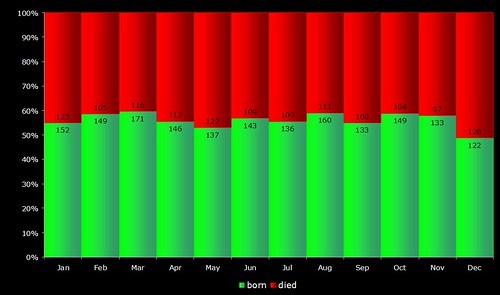
Number of births per year (surviving collaborators)
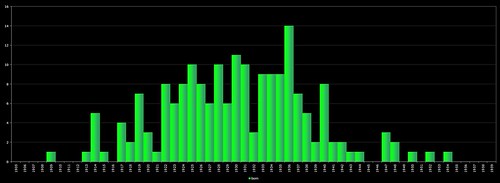
The most common year of birth for surviving collaborators is 1936. The only film actor who was born in that year was Bruce Dern — all the rest were actors in the TV series.
The oldest surviving collaborator is the Art Director and Production Designer Robert F Boyle, and the youngest is actor Bill Mumy who went on to play the role of Lennier in “Babylon 5”.
The oldest actress is Frances Reid and the oldest actors include Kevin McCarthy and Norman Lloyd.
Notes
The data is based on anyone who has a biographical entry on the Hitchcock Wiki (which certainly isn’t everybody). This includes actors and cast/crew for films and television programs, as well as some of the people who’ve appeared in Hitchcock DVD documentaries.
For the “still alive” list, sometimes I’ve made a best guess — this is usually based on whether or not the IMDB shows them as still being active in film or television in the last couple of years, or if the site lists their current whereabouts.
Month: August 2007
Libraries, teenagers and 2.0?
I’m doing a short presentation at an event in Wolverhampton in October (“Inspiring the iGeneration – Web 2.0, teenagers and libraries”) and I’m on the hunt for fun examples of how libraries (especially public libraries) are using “2.0” to attract teenagers.
I’ve got a few examples, but I’d love to hear about things you’re doing at your own library (e.g. gaming evenings, web content creation, etc) or things that you know other libraries have done. Even if it’s not really “2.0”, but it’s worked well in getting those teenagers in, then again I’d like to hear about it. I’m also really struggling to find examples in the UK, so if you know of anything, please let me know!
There’s been quite a bit of negative discussion recently about teenagers and computers in libraries (e.g. they use them to play games rather than to do their homework, or spend all their time on MySpace/Facebook/etc). I’d be interested to hear your comments about the subject (either negative or positive).
Check out these trends
…sorry, but that was the best blog title I could come up with at 10pm after a long day 😉
In a previous post, I mentioned that the circulation figures were up for the year so far (when compared to 2006). That got me wondering what the long term trend was for items checked out. Unfortunately there are some sizeable gaps in the historical data (as stored on Horizon), otherwise I’d be able to go back as far as 1996.
Anyway, here’s how the number of check outs per month pans out since 2000…
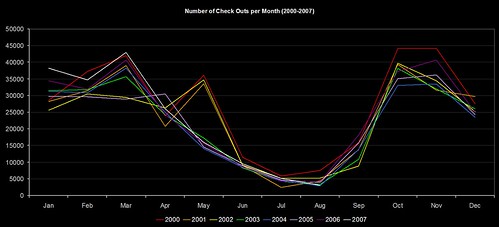
…or if you prefer your lines to be smoother…

The CKO data for this year is in white.
There’s a marked change after 2002 in the period around May, and (if memory serves me right) the structure of our academic year changed in September 2002. The overall figures indicate that we had a slight decline around 2003, but it’s been climbing gradually since then. So, much as I’d love to take the glory for our increased CKOs this year, it’s probably just following the recent trend.
Finally, here’s the same graph, but adjusted for an “academic year” (Sep-Aug)…
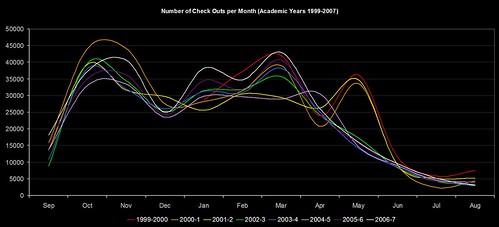
Yay!
Just catching up with some of my unread Bloglines and this post over at Shhhh!! made me snigger into my morning coffee 🙂

Rock The Reference Desk
If you build it, they’ll come back for more!
I’m just busy putting together slides for some of the upcoming presentations and I thought it was about time I trawled through some of the OPAC usage stats to see if our students are still using some of the OPAC tweaks we’ve made.
The good news is that they are, and then some more!
First up, here’s the overall usage for 4 of the tweaks (May 2006 to July 2007):
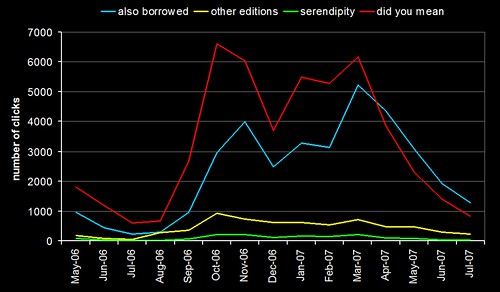
At first glance, nothing too surprising — the overall trend follows the academic year, with the lull over summer.
What did leap out was the blue line (clicks on “people who borrowed this, also borrowed…” suggestions) — since this April, the usage has been higher than the “did you mean” spelling suggestions (red line). So, either our users have suddenly become better spellers, or they’re making much higher usage of the borrowing suggestions. If I was a betting man, I’d say it was the latter.
We’ve now got enough data to compare the same 3 months in 2006 and 2007 (May to July):

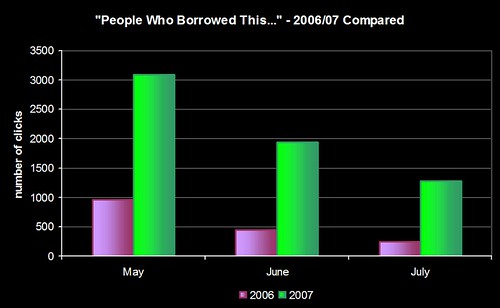
That second graph is why I’m sat here with a grin like a Cheshire Cat 😀
[update]
I’ve dug out the circulation stats for the same period and that re-inforces the statement that the students are making much higher usage of borrowing suggestions in 2007 than in 2006. You can see that the number of check outs (bold pink) pretty much matches the number of clicks on the “did you mean” spelling suggestions (red line in the first graph). Check outs have also risen in 2007 when compared to the same months in 2006.
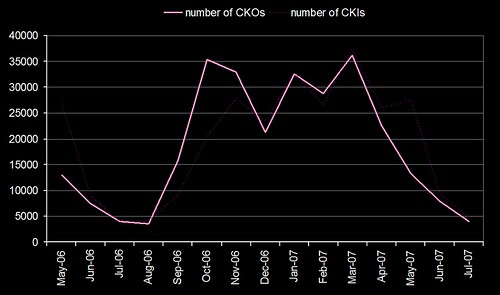
Interestingly, I don’t think we’ve ever had a student go up to a member of staff and say “I’ve found the suggestions really useful” or “thank you for adding spell checking”. I wonder how many complaints we’d get it we turned the features off?
52,000 frames of Hitchcock
Back in January, I set myself the task of reducing every one of the available major Hitchcock films down to 1000 frames of film.
Today, nearly 7 months later, I’ve finally finished 🙂
I’m guessing this is probably the largest online collection of images from Hitchcock’s films, with a total of 52,000 images covering a creative period of over 50 years, and taking up 3.76GB of disk space.
However, there’s still more work to be done! With the help of some fellow fans, I’m starting to catalogue the images — in particular, which actors are in each frame and what’s happening or what objects appear. It’s still early days, but here are some examples from the films that have been catalogued so far:
- Cary Grant and Grace Kelly together
- kissing
- food/eating
- James Stewart on the telephone
- Janet Leigh driving
- knives
- looking towards (or just past) the camera
- pointing
- female legs
- alcohol
- newspapers
- mirrors
The images are also starting to be integrated into the actor/actress pages in the site (e.g. Tippi Hedren).
Also, inspired by a comment in Charles Barr’s “English Hitchcock“, I’ve begun documenting film credits as well intertitles from the silent films (e.g. Champagne).
The final thing I’ve been adding in the last week or so is content from YouTube. The aim is to have videos for each of Hitchcock’s cameo appearances (e.g. Vertigo), interviews (e.g. Picture Parade), and film trailers (e.g. Frenzy).
So, now you know why I’ve not been blogging much recently 😉
Congratulations Casey!
Contrary to any speculation you might see on snopes.com, I haven’t been abducted by aliens, joined a monastery, or fallen down an open manhole cover — the last couple of months have been fairly hectic and although I’ve kept saying to myself “I must remember to blog about XYZ”, life just keeps throwing stuff in my way.
Anyway, this morning I found out that Casey Durfee has left the Seattle Public Library to become the latest employee of LibraryThing — specifically he’s going to be working on the LibraryThing for Libraries product.
I’ve lost count of the number of times I’ve added something to our OPAC or written a bit of code that I thought was new & cool only to find out that Mr Durfee had already done it.
I think I’m already on record as saying that if I lived in the USA, I’d camp outside Tim Spalding’s house with a large sign saying “Please let me work for LibraryThing! Will write code for coffee and peanuts!”. Come the day that LibraryThingGlobalHyperMegaCorpLtd opens its first UK office, I’ll be there with my sign.
So, with a huge amount of envy, I’d like to wish Casey all the best in his new job. I’d also like to thank him for the hundreds of helpful emails he’s sent to the IPAC and Horizon mailing lists over the last 6 years — there were many times when I seriously wondered if Casey knew more about how HIP worked than the developers at Dynix (and then SirsiDynix) did!